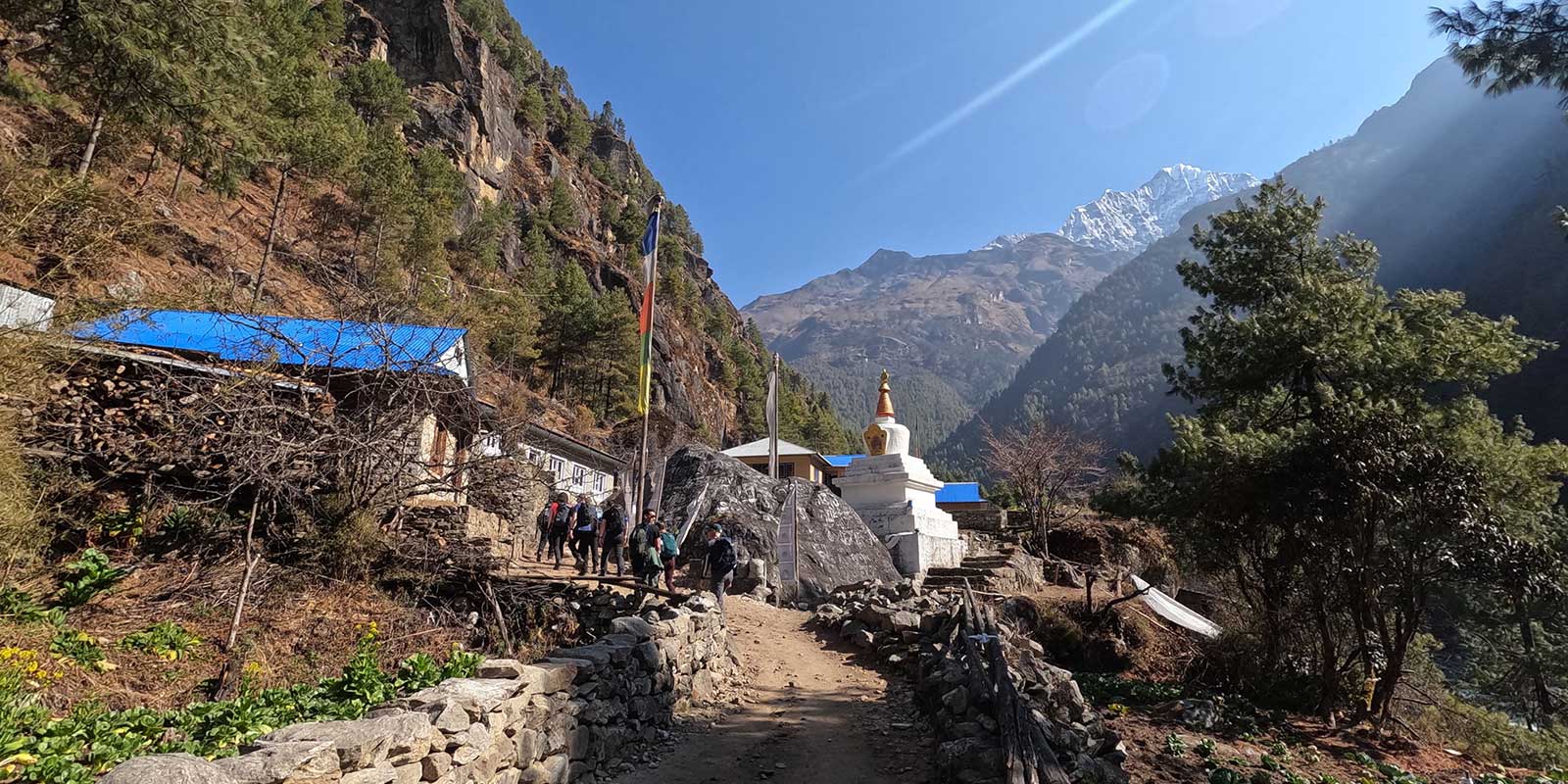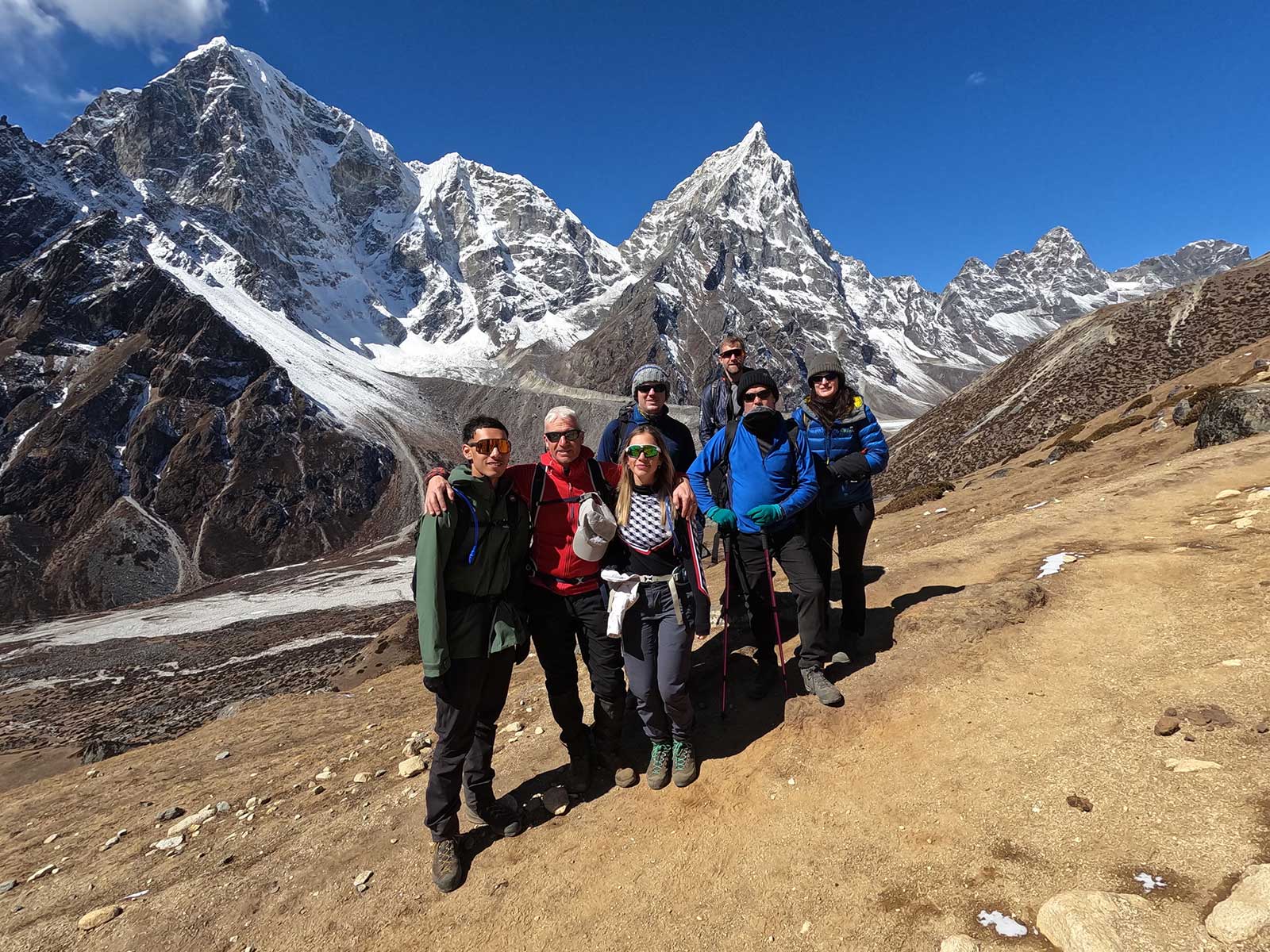
“To be the one to view the world’s tallest mountain”; is a simple enough reason to choose the Everest Base Camp for your trek. Tracing your trails through the culturally affluent villages of Sherpas, the unrealistically beautiful Khumbu, and reaching the height of 5545m to view the spectacular scenery of Mount Everest, you will most definitely never regret this trek of yours!
But to enjoy every second of your trek here, you must thoroughly research before booking a flight to Kathmandu, Nepal. And with that research, you must be attentive toward the time you plan to do this trek.
Make sure to read till the end because we will provide you with the best answer to your question, “When is the best time I complete my Everest Base Camp?”
All the professionals, including the guides and advisors of Icicles Adventure, would recommend this pre-monsoon time of the year.
Sunny days, supreme and unclouded views and warm enough days make this season a convenient time to complete your goal of trekking to Everest Base Camp.
You will also enjoy the lavish greenery during the trekking, including the beautiful red and pink Rhododendrons! However, be aware of unexpected showers!
At the beginning of the Spring, you will have a good trek up to the Everest Base Camp, with the days getting warmer. But this is not the only reason for March to be your ideal time.
Around this time, the sky is clear, giving you a spectacular view of Mount Everest from Kala Pathar. The forests also come to life this month, and you can enjoy a few days of your hike through the lustful green forests with all flora and fauna.
As March is not Nepal’s peak travel month, you can book flights and teahouses for your trek without worrying about it being fully booked. It will also be easy to pull people out of your shots if you take some good ones, which you obviously will after traveling this far!
Still, note that the temperature can drop to -10°C at night in early March and 0°C in late March at a higher altitude of Everest Base Camp. So, prepare yourself with warmer clothes expecting a colder environment despite the season.
Moreover, heed attention to the weather news as there might be occasional snowfall at the higher elevation.

This time of the year is the middle of Spring; thus, the weather is stable, and the days get longer. The days are sunny and warm, with a few occasional rain showers.
Even in higher elevations, you rarely see snows blocking your trail in April. The temperature at Namche Bazar (acclimatization point at 3440m) varies from 1°C to 12°C with the declining temperature at higher elevations.
April provides perfect weather and a spectacular view. Despite the busy trials, this is enough reason to choose April for your trek.
Moreover, while traveling from Kathmandu after your flight to Nepal, you can celebrate Nepali New Year, usually mid-to-late April.
May is the last month of Spring, with days getting longer and warmer. The mornings are clear this month, and afternoons can get cloudy, with occasional thunderstorms, hail showers, and strong wind. However, there is less crowd, so you can enjoy your trek even better!
The days are hotter, with the temperature reaching up to 24°C, while nights can be cold, with the temperature hitting 0°C.
To add more excitement to this month, you can plan to participate in the Tenzing Hillary Everest Marathon on May 29. Participants can run a 60 or 21-km trail from ECB through the Khumbu Valley.
This season comes after the season of heavy rainfall, making your views clear and the path of your hike full of greenery. Autumn is when you can view the best panoramic view of mountains and trails full of lively floras and fauna.
Along with the warm weather, you will find many fellow trekkers to connect with and interact with in this trekking season!
Despite being a good season, the weather might get bad unexpectedly. Still, it remains only for a short period without disturbing your trek.
The trek is challenging, but this month makes it a little less strenuous and much more worth it than any other month.
September is neither hot nor cold, with the temperature being 18°to 24° at lower altitudes and a minimum of -15°C at higher altitudes. Moreover, with the recent monsoon season, the month will be full of greenery, giving you a chance to enjoy every step of your days of trekking.
The number of trekkers is less in September compared to other months. Hence, you could enjoy your trek with fewer people. But the trails get busy again by the end of the month.
Moreover, be prepared for the flight cancellation to Luka because of the bad weather.
October is one of the busiest months for trekking to Everest Base Camp because of its perfect weather and temperature. With the clear sceneries and the snow-covered mountain, you can enjoy your daily hike through the dry trail enjoying floras and fauna.
However, the high flow of trekkers during this month will cause the price to escalate, and there might be difficulties in scheduling your flights. Therefore, it’s best to plan your trek in October way ahead of time.
This is the best month to consider trekking to three passes!
Also, you can book your flight to Luka without worrying about flight cancellation.
The temperature is a maximum of 12°C and a minimum of -6°C.
What’s more? You have a once-in-a-year opportunity to enjoy the major festivals of Nepal, Dashain, and Tihar with the locals!
November is perfect if you want to avoid the unwanted crowd in October! Of course, October might be an ideal month, but this is little secret others don’t usually tell you; November is even better!
The number of trekkers declined compared to October, but the fascinating view you go there for is still crystal clear. The temperature can lower from 0.9°C on days to -17°C at night, making the weather slightly cold.
You may encounter snowfall during this time of year. Therefore, we usually advise you to avoid more strenuous routes because of the changing weather if you are new to trekking.
Moreover, you can still enjoy the festival of light, Tihar!
With the off-season in Nepal’s tourism industry, it might still hold a great deal of adventure for explorers but with a little bit of risk.
Expect the weather to be hot and days to have lots of rain!
With this, you must remember that flights get canceled frequently because of this lousy weather during these seasons.
Frequent rainfall and cloudy days will block your view in both seasons, as the weather in the Summer of the Himalayan region is influenced by the Indian monsoon.
Still, enjoyable summer trekking in rain shadow regions of mustang, Dolpo, etc., is possible, as they have significantly less rain.
The first 10-15 days of June are still good, but only a few trekkers are seen while the climbers are retracing their way home. The weather is cloudy, and you won’t get the best view of Mount Everest; however, the trek is not impossible. You can still join the expedition if you adjust to these facts.
There are rain chances, mostly in lower elevations, but you will not encounter them at higher altitudes. Expect obscured view if you are prepared to start the trek this month. You would not have to worry about the accommodation at tea houses as the trek is primarily empty this month.
The temperature during the day can be up to 17, while the temperature can drop to -2°C at night.
If you like peace and can deal with the monsoon, you can still trek during this year. The altitude above 4000m will have fewer rain showers, but be prepared if there are any.
With the disadvantages of rain, it has its own points to travel. First, you will be traveling in the off-season; hence, less of a crowd. If you are lucky after the rain clears out, you may also get a quick view of Mount Everest, making it all worth it.
The temperature can be up to 17° during the day and can fall low to -2°C at night. So carry your 0° sleeping bag for the cold nights!
This is the whole last month of the monsoon and off-season for trekking, so you won’t have trouble finding accommodations in the tea houses there. But, unfortunately, you won’t find many trekkers either.
We highly recommend you base yourself at Namche bazaar and go for day treks if you plan to travel this month. You will not be missing any of the spectacular views staying here! Instead, you will be reducing your risks.
The temperature could reach 16°C during the day and a minimum of 2°C at night. Therefore, prepare for cooler nights as you hike up to greater altitudes.
This is the best time only if you want to take the challenge to trek Everest with some problematic conditions. The days can be warm, but the nights go below the freezing point in this season. Moreover, the weather will be windy this season, making it difficult to go further in higher elevations.
With the risk involved, you will find a peaceful trek with a spectacular view of snowed mountains if you travel this season.
We advise you to trek in lower elevations during this season as the higher altitude might be difficult and risky with the bad weather or snowfall blocking your trails.
A fact to learn: throughout the entire year, this is the season with the most stable weather condition!
With the beginning of winter, spectacular sights in the early mornings and evenings will be obstructed.
With fewer trekkers during the winter, you can find better accommodations at a cheaper during your trek, along with an empty and peaceful trail.
Remember that the trek is still moderate to challenging during winter. The trails can be rocky, snowy, and steep, with frequent snowfall blocking your tracks at higher altitudes.
The temperature might drop from 9°C to 0°C during the day and -1°C to -17°C during the night as you go to higher altitudes. Yet, despite the freezing temperature, the views are crystal clear as the fogs and clouds gather at the lower region.
This mid-winter month leaves you with heavy snowfalls and blocked trails at higher altitudes.
Despite the off-season, you will be in a difficult position as the tea houses at higher elevations are closed. So, you better hire a guide to save yourself from many possible difficulties.
We recommend you do this trek in January only if you are an experienced trekker because of the high risks involved in different trails.
Namche Bazar will have a temperature between -8°C to 6°C, which will decrease as you hike to a higher altitude.
February marks the end of winter as the rainfall and snow decrease. If you travel this month, you will have longer days, and there will be a treat of a fantastic view of snow-clad mountains! What more? You will have an entire trail to yourself!
Other than a few snow days, the skies will generally be clear. But make sure to protect yourself from UV radiation at higher altitudes!
The temperature could fall to -4°C during the day and drop to -17°C at night, making it harder to reach higher altitudes.
It can be risky to hike towards higher passes, so accompany a guide if possible and constantly check weather reports to avoid nasty accidents.
Considering every factor, we recommend the months of March, April, May, October, and November for your Everest Camp Base trek. However, this trek can be fun and adventurous at any time of the year.
Still trying to figure it out or have more questions? Then, do not hesitate to contact us! With professionals to consult, we will ensure you have the best time on your trek of EBC.
Leave Your Comment